E-Museum of Pyrographic ArtAntique Art Hall
|
| - Café Flambé - | - Portraits and Paintings - | - Decorative and Applied Art - |
| - Folk and Traditional Art - | - Antique Art - | - Special Hall - | - Sculpture - |
| - Children's Hall - | - Bookstore and Library - | - Tools and Techniques - |
 |
| St. John at Patmos Reredos of St. John's Vision from Revelations By J. William Fosdick Fire etching and color on wood reredos, Presented by Wm. T. Evans to the Episcopal Church of St. John's, Montclair, New Jersey, U.S.A. Digital image from black and white photograph in a 1908 publication entitled American Review of Reviews edited by Albert Shaw, p. 566 |
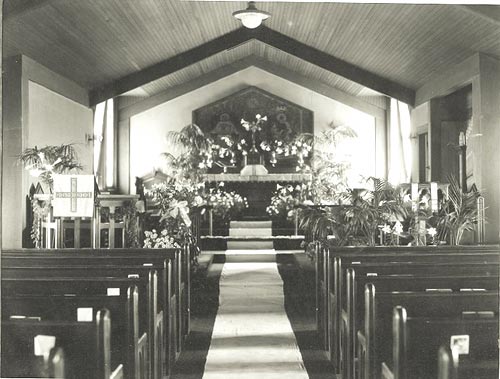 |
| St. John at Patmos Reredos of St. John's Vision from Revelations By J. William Fosdick Fire etching and color on wood reredos, Presented by Wm. T. Evans to the Episcopal Church of St. John's, Montclair, New Jersey, U.S.A. Digital image from a black and white photograph Courtesy of Rev. Diana D. Clark, Rector from the archives of St. John's Episcopal Church Montclair, New Jersey, U.S.A. |
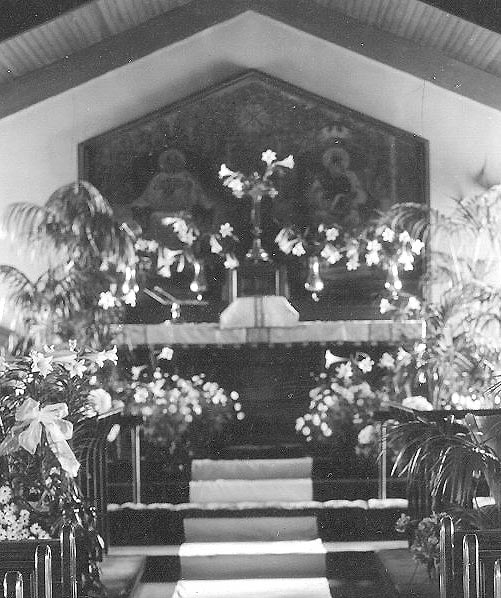 |
| St. John at Patmos Reredos of St. John's Vision from Revelations By J. William Fosdick Fire etching and color on wood reredos Presented by Wm. T. Evans to the Episcopal Church of St. John's, Montclair, New Jersey, U.S.A. Digital image from black and white photograph Courtesy of Rev. Diana D. Clark, Rector from the archives of St. John's Episcopal Church Montclair, New Jersey, U.S.A. |
 |
| Heraldic Shield, Kennard Family By J. William Fosdick, 1901 Fire etching on pine wood heraldic shield, 32 in. by 34 in. Digital image courtesy of Thomaston Auction Galleries, Thomaston, Maine, U.S.A. |
 |
| Heraldic Shield, Kennard Family, detail of the family motto
"AT SPES NON FRACTA" (HOPE IS NEVER CRUSHED) By J. William Fosdick, 1901 Fire etching on pine wood heraldic shield, 32 in. by 34 in. Digital image courtesy of Thomaston Auction Galleries, Thomaston, Maine, U.S.A. |
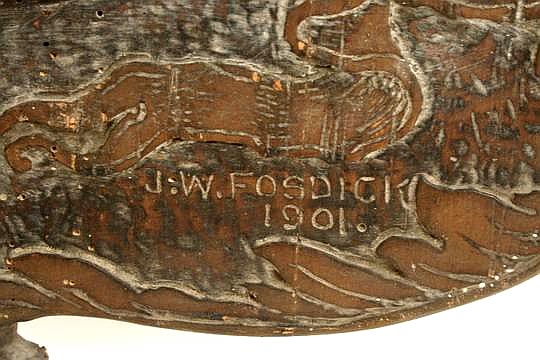 |
Heraldic Shield, Kennard Family, detail of the signatureJ. W. Fosdick By J. William Fosdick, 1901 Fire etching on pine wood heraldic shield, 32 in. by 34 in. Digital image courtesy of Thomaston Auction Galleries, Thomaston, Maine, U.S.A. |
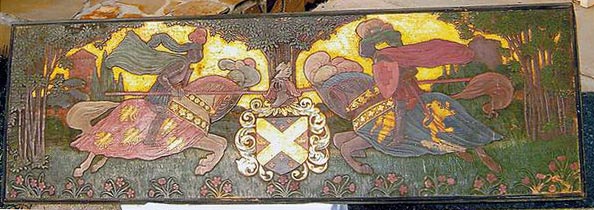 |
| Jousting Knights By J. William Fosdick Incised line painting on wood panel, 2 ft by 6 ft Digital image from a newspaper query, Knoxville, Tennessee, U.S.A. |
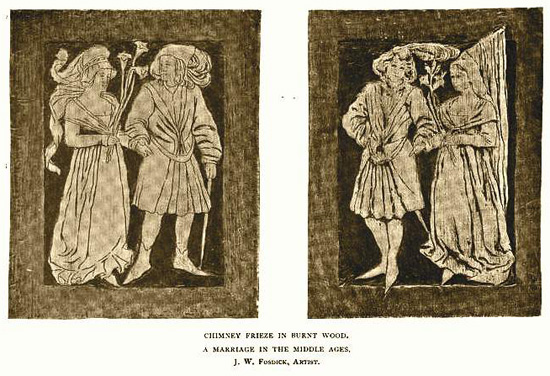 |
| A Marriage in the Middle Ages * By J. William Fosdick Fire etching on wood panel, see listing numbers 20 and 45 in the subsection below of "Additional Art Works by J. William Fosdick Cited" Image adapted from a 19th Century black-and-white photograph in a Yearbook and Catalogue of the Architectural League of New York City |
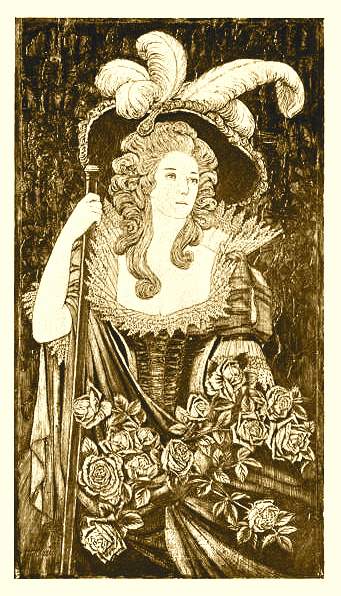 |
| Untitled*** "Portrait Decoration" By J. William Fosdick, circa 1897 Fire etching on large wood panel (See listing number 332 in the subsection below of "Additional Art Works by J. William Fosdick Cited") Digital image adapted from a 19th Century black-and-white photograph in a Yearbook and Catalogue of the Architectural League of New York City |
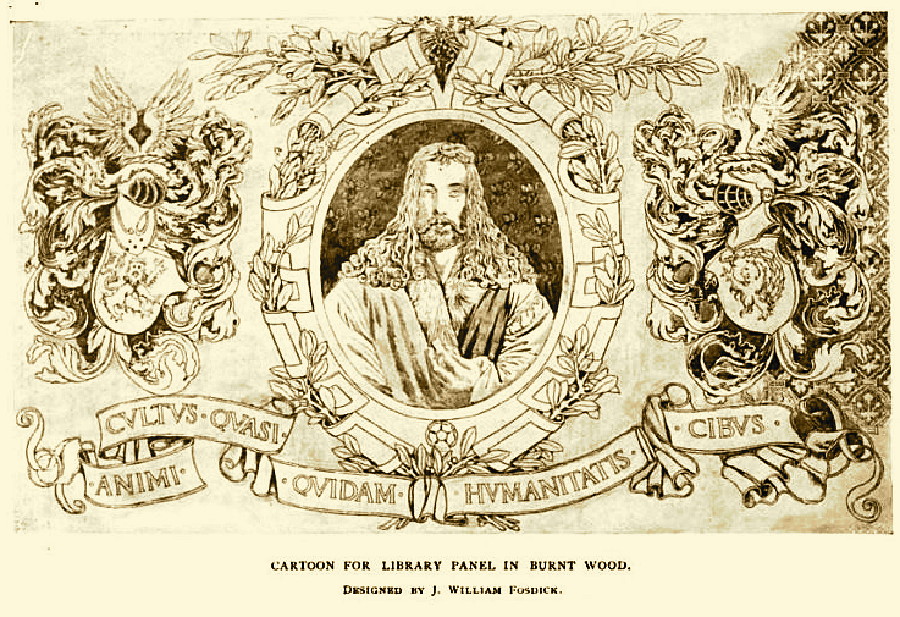 |
| Cartoon for Library Panel in Burnt Wood**** "Dürer Portrait" By J. William Fosdick Fire etching on large wood panel (See listing number 404 in the subsection below of "Additional Art Works by J. William Fosdick Cited") Digital image adapted from a 19th Century black-and-white photograph in a Yearbook and Catalogue of the Architectural League of New York City |
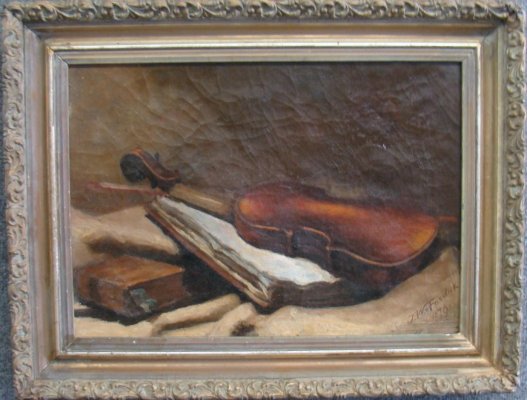 |
| Untitled (Still Life with Violin) Signed J. W. Fosdick, 1879 Framed oil on canvas, 20 in. by 14 in. Digital image courtesy of Carlens Gallery Greenville, New York |
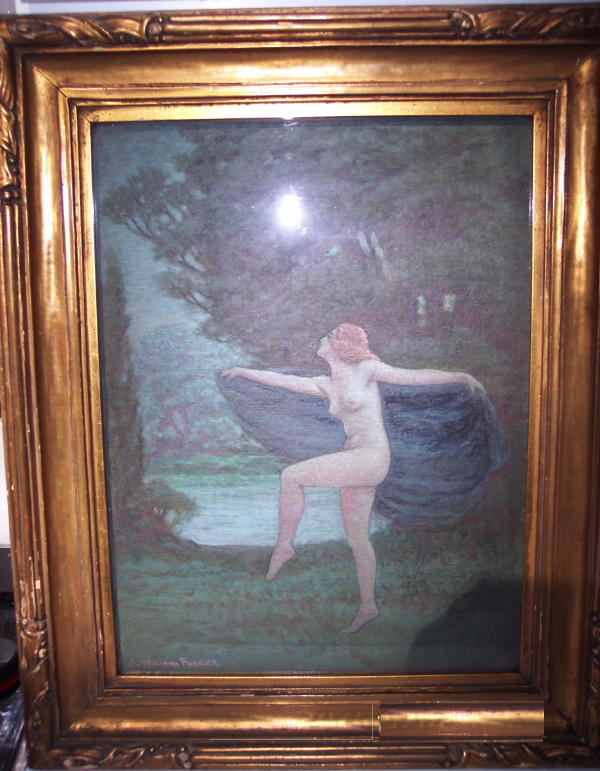 |
| Untitled (Dancing Nymph) by J. William Fosdick, circa 1877 Framed oil on canvas Digital image by the owner Mike Perrin |
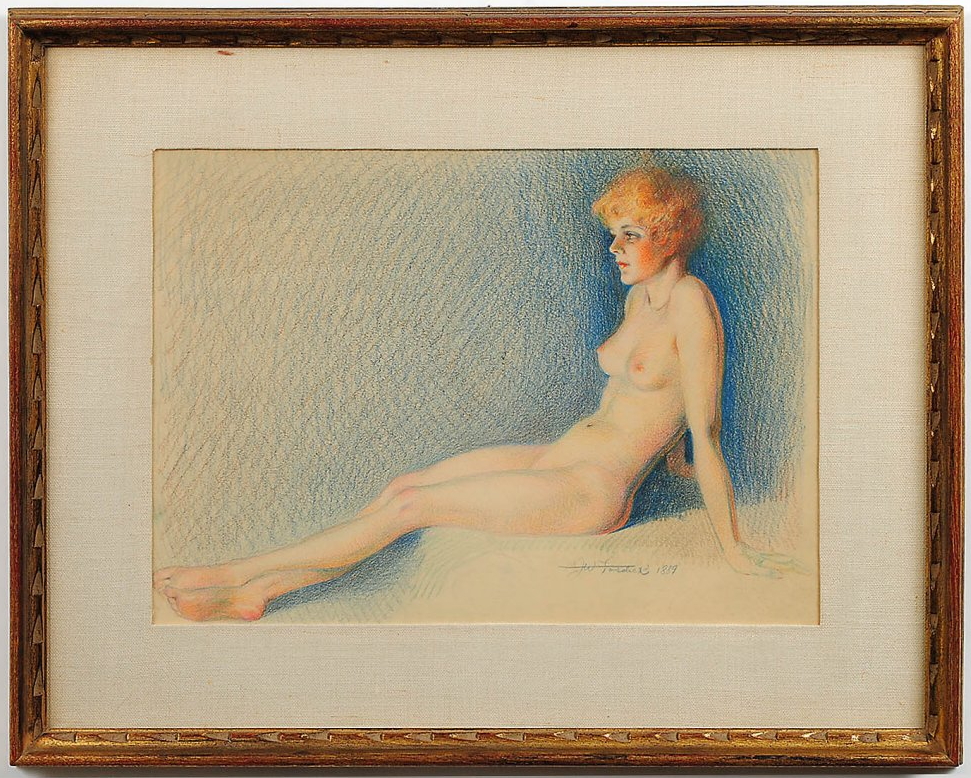 |
| Seated Nude Lady by J. William Fosdick, 1889 Framed pastel on paper, sight measuring 13 in. by 17-3/4 in. Note signature and date in lower right From the private collection of Robert E. Olsen Acquired through the Art Gallery of the Palm Beaches in Florida This digital image (and more) courtesy of the Live Auctioneers site |
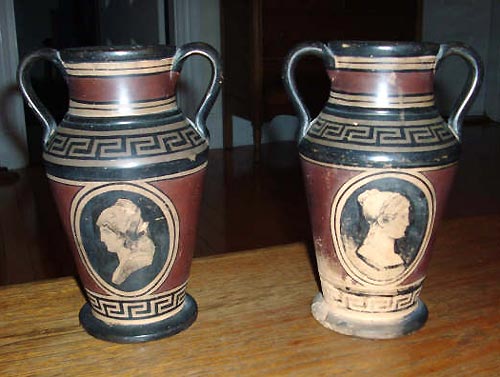 |
| Untitled (Pair of Grecian Urns) By J. William Fosdick, 1876 Pair of painted clay vases in style of ancient Grecian urns 8 inches tall, 3 inches diameter at opening Digital image courtesy of Scott Lovasco, owner |
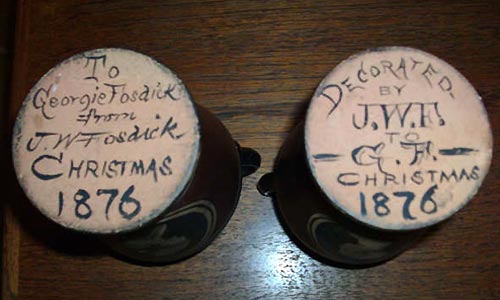 |
| Untitled (Pair of Grecian Urns), detail By J. William Fosdick, 1876 Pair of painted clay vases in style of ancient Grecian urns Detail of the inscriptions on the base 8 inches tall, 3 inches diameter at base Digital image courtesy of Scott Lovasco, owner |
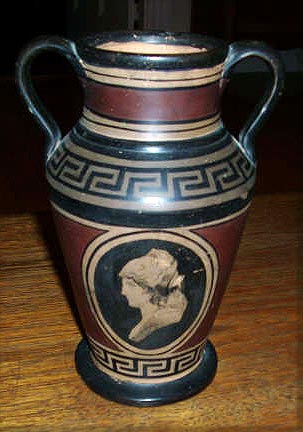 |
| Untitled (Pair of Grecian Urns), Urn No. 1 By J. William Fosdick, 1876 One of a pair of painted clay vases in style of ancient Grecian urns 8 inches tall, 3 inches diameter at opening Digital image courtesy of Scott Lovasco, owner |
 |
| Out of Bohemia: Bookcover Novel by Gertrude Christian Fosdick, 1894 Illustration by J. William Fosdick Digital image adapted from the bookcover illustration Untitled (Impromptu Spanish Dance) of the principal female character from the novel Out of Bohemia: a Study of Paris Student-Life written by Gertrude Christian Fosdick published by G. H. Richmond & Co., New York, 1894 hardcover, 236 pages |
 |
| The Honor of the Braxtons, Novel By J. William Fosdick, 1902 Novel of student life in France, illustrated published by J. F. Taylor & Co., New York, 1902 hardcover, 5.5 in. by 7.5 in., 305 pages Digital image courtesy of Princeton Antiques Bookshop |
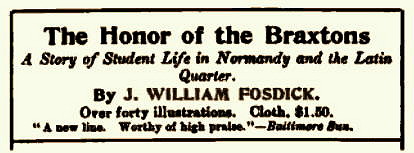 |
Small advertisement in The Dial: A Semi-Monthly Journal of Literary Criticism, Discussion, and Information, Edited by Francis Fisher Browne Volume XXXII, January 1 to June 16, 1902, p. 399 For J. W. Fosdick's illustrated novel of student life in France published by J. F. Taylor & Co., New York, 1902 hardcover, 5.5 in. by 7.5 in., 305 pages |
 |
| The Honor of the Braxtons, Illustration of the principal female character—Alina Durlan By J. William Fosdick, 1902 Digital image adapted from the Frontispiece illustration from the novel published by J. F. Taylor & Co., New York, 1902 hardcover, 5.5 in. by 7.5 in., 305 pages |
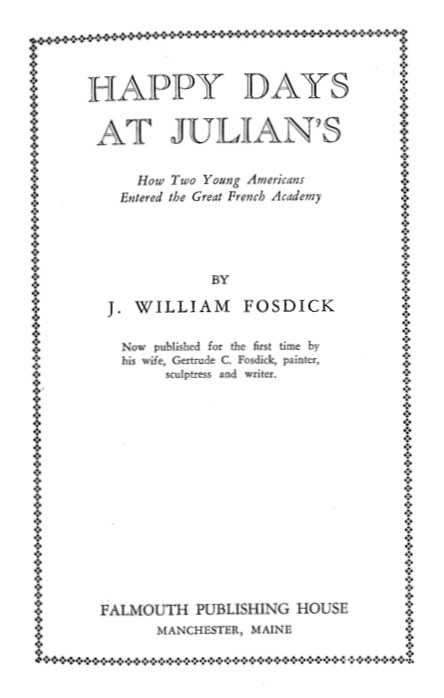 |
| Happy Days at Julian's: How Two Young Americans Entered the Great French Academy Title page of J. Wm. Fosdick's Memoirs, 1954 Published posthumously by his widow Falmouth Publishing House, Maine, 1954, 188 pages With thanks to Prof. Donna Campbell |
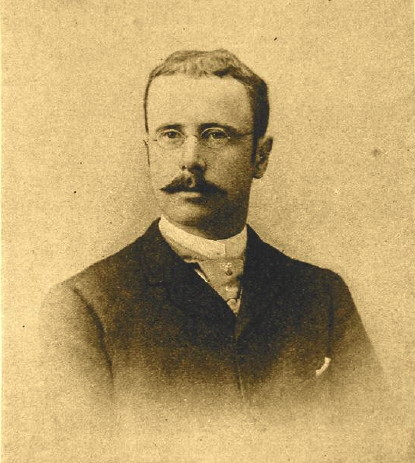 |
| Portrait Photograph of J. William Fosdick, at about 33 years of age See a larger image of this portrait in the 1891 J. W. Fosdick exhibit at the link here, which is the source article for it. |
American artist and writer J. William Fosdick born 1858 in Charlestown, Masssachusetts learned about pyrography, when still a boy, thanks to two 'poker-paintings' by Ball Hughes acquired by his father. When he showed interest in how they were done and started experimenting himself, Ball Hughes' widow Eliza (Wright) Ball Hughes invited him to her house in Dorchester, Massachusetts, and instructed him on what she knew about her late husband's technique. As a young man, he studied first at the Museum of Fine Arts School in Boston and later at the Académie Julian in Paris from 1881–1888. In 1884, he interrupted his studies in Paris to take his first commission for the American architectural firm of McKim, Mead, and White. That first commission came as the result of a reference from Eliza Ball Hughes.
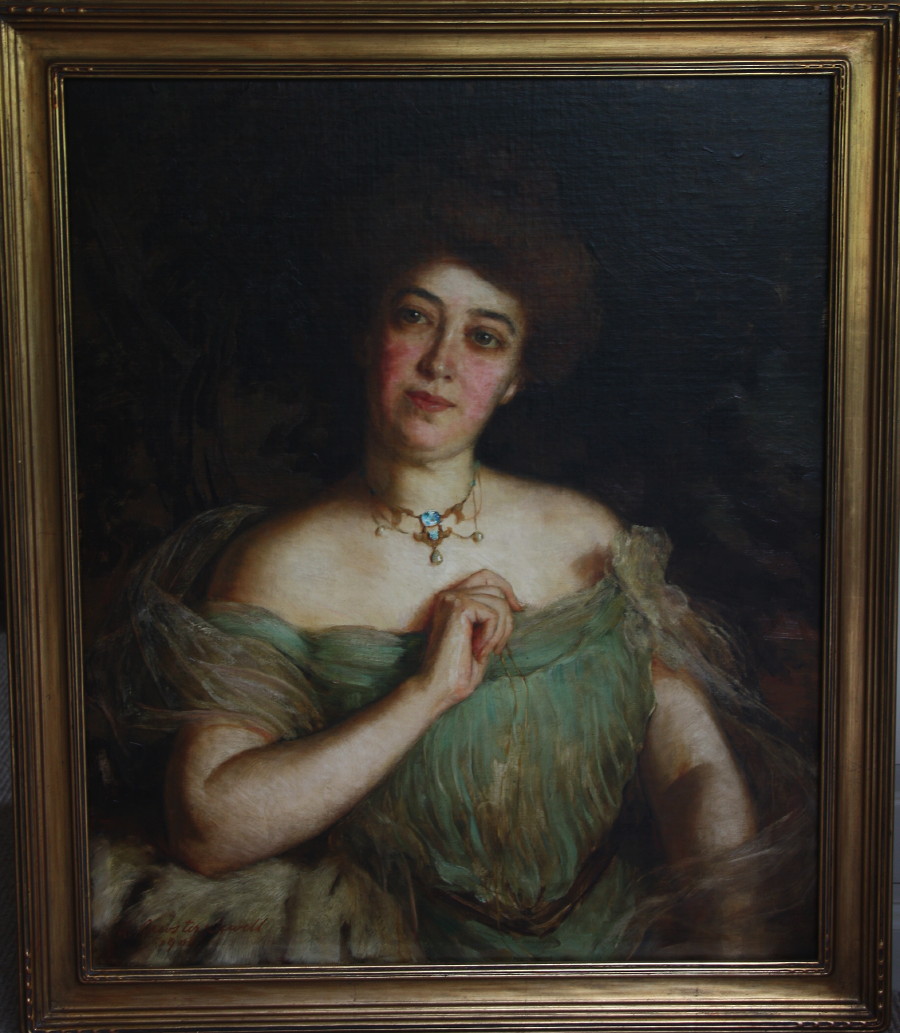 |
| Portrait of Gertrude Christian Fosdick, at about 44 years of age Oil painting by Amanda Sewell, 1906 See a larger image of this portrait in the Gertrude Christian Fosdick exhibit at the link here. That exhibit includes three paintings and two sculptures by her, as well. |
In 1890, Fosdick married Gertrude Christian (1861–1961), the daughter of Virginia Supreme Court Judge Joseph Christian from Richmond, Virginia. According to Prof. Donna Campbell, the couple met in Paris, no doubt because they both spent time studying there at the Académie Julian.
Gertrude was a sculptor and also a writer, as well as a translator. Of particular note regarding her expertise as a translator is her important first English translation among a team of translators of the novels of Honoré de Balzac in a 53-volume set published in 1897.
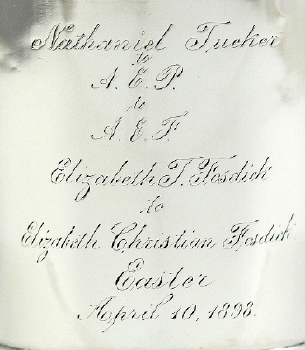 |
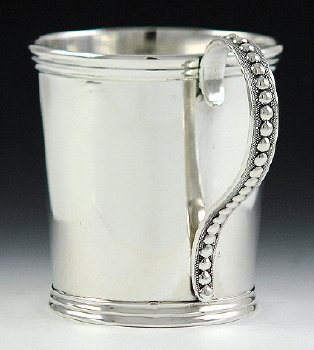 |
| Inscription on Heirloom Silver Baby Cup given to Elizabeth Christian Fosdick, at the time of her birth on Easter, 10 April 1898 |
1840's Baby Cup is made by Henry Haddock of Boston Diameter of Cup is 3 inches; Cup is 3-3/8 in. tall The handle is decorated with raised beads over a stippled texture. |
Thanks to genealogical researcher Bev Wright, who discovered the above little silver baby cup on eBay, we know a little more about the Fosdick family. From the inscription, it appears the little silver heirloom cup was a gift from the newborn baby's paternal grandmother.
According to one Who's Who account, the Fosdicks had one daughter, named Elizabeth Christian, who was born in 1898. As yet, no photograph has been found for their daughter, and little is known of her. However, according to one family account, she was not well, and there were no descendants. She died in 1967 in New York.
Notes on the Art Works Exhibited in This Salon
The colors in J. William Fosdick's first work exhibited here—the reredos St. John at Patmos shown in three black-and-white photos above—we can only know through the original descriptive caption that accompanied the first image, which is from a 1908 publication, The American Review of Reviews, edited by Albert Shaw:
"The reredos is in rich Venetian reds, blues and greens, much gold being used on candle-sticks, [sic] aureoles, eagle, and "Christus Rex" over the center."
Following that is the explanation of the unusual portrayal in the composition, which was inspired by the book of Revelations:
"St. John sits writing, balanced by his vision of Christ [Revelations]: Christ enthroned with seven candlesticks, holding in his hand the seven stars. In the center is the tree of life, and beyond the AEgean Sea, over which decorative clouds float."
Of historical note is that this work was presented to the
St. John's Episcopal Church at Montclair, New Jersey
by William T. Evans, the same person who in 1910 gave the triptych of the Glorification of Joan of Arc to the Smithsonian in Washington, D.C., where it is displayed today in the renovated American Art Museum that reopened in July of 2006.
Unfortunately, the story of this lovely reredos does not have the same happy ending. According to oral accounts, the reredos has not survived because, for some unknown reason, it was removed from the church in the 1960's and stored improperly (against the warden's garage) thus allowing it to be ruined.
The Kennard Family's Heraldic Shield (shown in three views above) was auctioned on the 4th of November 2007 through Thomaston Galleries in Thomaston, Maine. It is now in the private collection of Douglas Schneible of Charlotte, Vermont. The motto on the heraldic shield is not only that of the Kennard family but also of Hope & Co., their prominent early Dutch company in New York and the subject of a 724-page book by M. G. Buist with their motto for its title: At Spes Non Fracta. Hope and Co., 1770–1815: Merchant Bankers and Diplomats at Work.
J. William Fosdick's Jousting Knights panel exhibited above came to light as the result of a query—directed to the Knoxville, Tennessee News Sentinel—from a reader with the initials L. M., who owns this panel and wanted to know more about it.
L. M.'s query and Joe Rosson's reply to it were featured in his column on July 20, 2007, with the title "Rosson: If an original, work could be significant piece of U.S. art."
The pair of panels for a chimney decoration entitled Marriage in the Middle Ages and the untitled decorative portrait displayed above were found as catalogue illustrations for the Architectural League of New York City in some of their Victorian publications. The untitled decorative portrait later became known as Lady Gainsborough and is displayed in its own salon here in the E-Museum with additional details of its history.
Done when J. William Fosdick was only a young man of 21, is the 1879 oil painting, Still Life with Violin, which went up for auction in May 2009 at the Carlens Gallery of Greenville, New York. It can be viewed in more detail in a very nice presentation at the link here.
A signed but undated oil painting by Fosdick of a Dancing Nymph in the meadow, is owned by Mike Perrin, who acquired it in Manhattan more than 30 years ago and is now considering selling it. Contact him at either the link here (to the title) or in the caption for the "Dancing Nymph" above. This work is believed to date from about 1877 or 1878, when Fosdick was studying in Boston under Grundmann. (It is similar in theme and style to a work shown at ArtNet entitled "Nymphs by the Waterfall.")
Another work by Fosdick—a pastel on paper entitled "Seated Nude Lady"—appeared at a significantly later date. The date is significant because this work is not from his earlier days as a student in Boston, but a year after his return to the United States following completion of his studies in France. By that time, Fosdick was working (almost, apparently) exclusively in pyrography. The owner, Robert E. Olsen of Virginia, describes the subject as a "very modern nude." He believes that this pastel work by Fosdick "...looks like a study for another piece. In any case," he adds, "the casual pose, the short hair style, and the model's proportions resemble works of other artists from much later periods."
The earliest known art work by J. William Fosdick to date is the 1876 pair of painted clay vases in the style of Grecian Urns (displayed above in three views) done when the artist was only 18 years old as a Christmas gift for "Georgie Fosdick"—most likely his sister Georgiana, who was 22 years old at that time. The provenance of the pair is most intriguing: a Mr. Goldberg of Lexington, Massachusetts said that the clay vases were found about 60 years ago inside of a wall during renovations to his boyhood home in Charlestown. (Those renovations occurred about a decade after the artist's death in 1937 and in the city of the artist's birth.) The vases remained in Mr. Goldberg's family ever since until recently when they were sold as "old handmade pottery" to the present owner, Scott Lovasco, who is offering them for sale. (To contact him, click on the link in this paragraph.)
Novels and Collaborative Works
Because of their many commonalities, it is not surprising that the Fosdicks collaborated on some projects, such as the novel that J. William Fosdick's wife Gertrude wrote (published in New York by George H. Richmond & Co., 236 pages, 1894). Below, from The American Magazine, 1894, p. 127, is what one critic of her time wrote about her book Out of Bohemia: A Student's Life in Paris:
"OUT OF BOHEMIA" is a woman's story of art-student
life in Paris, written in a very pretty, naive style by Gertrude Christian Fosdick, and sympathetically illustrated by J. William Fosdick, the master of the art of burnt-wood or "fire etching," and whose illustrative as well as literary work is well known...."
In that same issue of The American Magazine—well worth a look—J. William Fosdick is cited once more on page 393 as a regular contributor to Frank Leslie's POPULAR MONTHLY. Reprinted there, from the October 1894 issue, pp. 385–396, is a wonderful historical article, Modern Magazine Making with great old photographs.
The Fosdicks' collaborative novel returned to the spotlight recently when Dr. Donna Campbell (Associate Professor of English at Washington State University) presented an invited paper, A Forgotten Daughter of Bohemia: Gertrude Christian Fosdick's
Out of Bohemia and the Artists' Novel of the 1890s, at the Society for the Study of American Women Writers (SSAWW) conference in Philadelphia, November 8–12, 2006. Note that this novel is in the collection of Harvard University's Houghton Library and can be obtained through interlibrary loan, and now on the internet, as well.
As of November 2007, Gertrude Christian Fosdick's novel
Out of Bohemia is available at this link—in its entirety—to read on the internet, thanks to Google Books. Navigate the internet book by clicking on the small arrows immediately above and to the right of the page image. Note that there are several blank pages in the front matter at the beginning; however, amidst them are some important ones not to be missed, including a handwritten dedication by Gertrude's father Joe Christian, dated 1894, and the lovely frontispiece illustration of the principal female character Beryl Carrington (the same one that was used for the book cover). Once past the front matter, the page numbers appear in the little box between the two arrows.
As a sculptor, Gertrude exhibited some of her works in shows, according to Prof. Campbell, who also noted that one of Gertrude Fosdick's works is a memorial tablet at the site of the Stacy Blvd. Memorial in Gloucester, Massachusetts, where it is located near the drawbridge on the Stacy Blvd. esplanade. A small bronze sculpture entitled Dancing Girl by Gertrude Christian Fosdick is in the collection of the Virginia Museum of Fine Arts in Richmond, Virginia. Along with a larger image of her portrait, there are three paintings and two sculptures by her exhibited in the Gertrude Christian Fosdick Salon in the E-Museum at the link here.
* Update, June 2012: A 90th Anniversary Exhibition is planned at the
The North Shore Arts Association at 11 Pirates Lane in Gloucester, Massachusetts, from August 16 to September 18, 2012. There will be a reception held there on Sunday, August 19, 2012, from two to four o'clock. Represented there among other artists' works will be works by Gertrude Christian Fosdick, who was one of their founding members. Follow the link to
their site for additional information.
In 1902, J. William Fosdick likewise wrote a novel on the topic of student life in France entitled The Honor of the Braxtons (see image above). His novel has a pretty picture (also above) of the principal female character Alina Durlan on the frontispiece accompanying the title page, and there is conjecture that perhaps he used his wife's image there.* (The link here is to a May 1902 review of his novel in The Literary News.)
* Update, March 2012: A paperback reprint of Fosdick's novel
The Honor of the Braxtons is now available through Barnes & Noble at the link here to the title.
Although there is no photograph yet to be found for her, there is a known portrait of Gertrude Christian Fosdick painted by Amanda Sewell in a private collection in Virginia, according to the American Painting and Sculpture database of the Smithsonian American Art Museum's Inventories.
* Update, July 2011: Thanks to Robert Hill of Virginia, we now have an image of Amanda Sewell's portrait of Gertrude Christian Fosdick at the link here to her name. It reveals that she did not look like the Alina Durlan character in her husband's book nor like the young woman in the little piece called "The Smile of Peace," (exhibited immediately following) which also looked a lot like the Alina Durlan character. Instead, it now appears that the likeness he illustrated was to her own character of Beryl Carrington that is the bookcover and frontispiece illustration to Gertrude's novel.
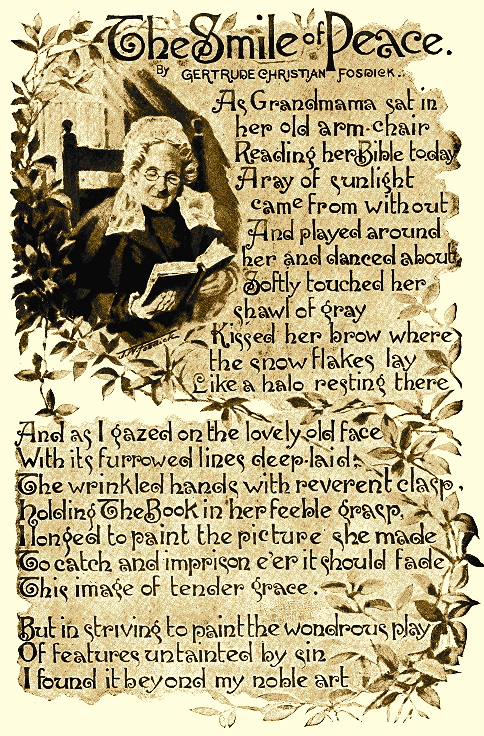
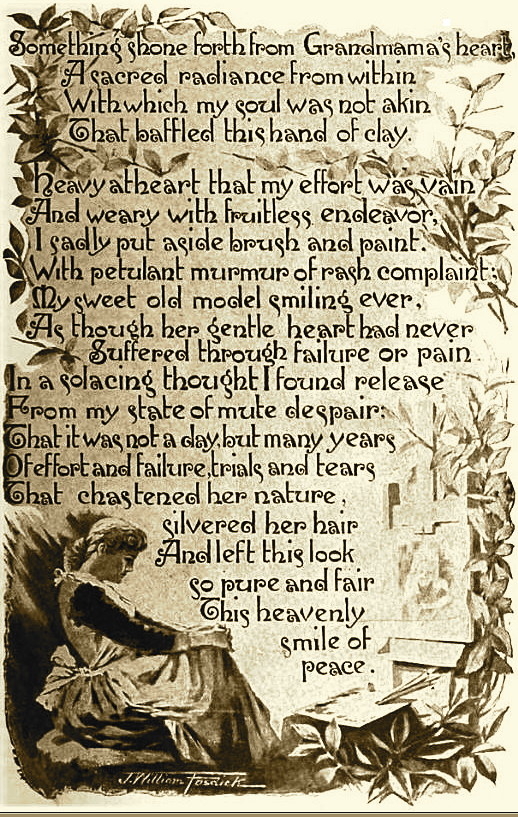
The Smile of Peace,
Published in The New England Magazine, volume 12, issue 2, pp. 186–187
This is a little collaborative piece written by Gertrude Christian Fosdick and illustrated very nicely by her husband J. William Fosdick.
According to Prof. Donna Campbell, in her article published for Project Muse in 2008, Gertrude Christian Fosdick, in 1954, published her late husband's memoir, entitled, Happy Days at Julian's: How Two Young Americans Entered the Great French Academy. Thanks to Prof. Campbell, exhibited above along with their novels is the title page of Happy Days at Julian's.


Published in The New England Magazine, volume 12, issue 2, pp. 186–187
This is a little collaborative piece written by Gertrude Christian Fosdick and illustrated very nicely by her husband J. William Fosdick.
Additional Art Works by J. William Fosdick Cited
The earliest known pyrographic work found for Fosdick was cited in the 1878 catalogue of the Exhibition of the Massachusetts Charitable Mechanic Association when he was about 20 years old studying art in Boston. His work was listed in the section on FINE ARTS, Category 3, DRAWINGS, on p. 53, as entry number "631: POKER DRAWING. J. W. Fosdick." His was the only poker drawing listed among the 73 entries in that category.
An early exhibition of his professional career once he returned from Paris in 1888 was his 1889 St. Louis Exhibition. The catalogue for that exhibition can be viewed at the link here, which includes 28 works by Fosdick and the two he owned by Ball Hughes.
At Artnet.com, two works by Fosdick are cited (with an image) as sold at auction: one, listed as sold in 1994 by Sotheby's of New York, was described as a signed oil painting on canvas (but no mention of a date), 30 in. by 24 in., and entitled Nymphs Playing Near Waterfalls. What looks like the same (or almost the same) painting with a slightly different name—Nymphs by a Waterfall was cited (also with an image) as being sold at auction in 1990 through Doyle of New York. It is not clear if this is the same work sold twice—in 1990 and again in 1994—or if Fosdick painted the same theme twice. The images are shown together at this artnet.com page; however, it is still not definitive, since the photographs could be different rather than the paintings.
ArtFact.com also cites two works by Fosdick sold at auction: one is the same 1994 auction by Sotheby's of New York noted previously but with no image at this site. The other listing, likewise without an image, is for one sold in 1988 by Bourne of Massachusetts, entitled Over the Terrace Wall. It is described as a woodburning on oak panel, 13.75 inches by 10.75 inches, of a woman wearing a bonnet by a brick wall, signed and dated lower left, "F/N York/1890," and with a presentation on the verso, "To my good friend Dellenbaugh/The Sherwood, New York 1894/J. William Fosdick." ArtFact notes the condition as "outstanding" and that it has the original finished oak frame in good condition. They also note that Fosdick exhibited at the National Academy in 1889 and 1890. [Curator's note: Could Dellenbaugh be Frederick Samuel Dellenbaugh, anthropologist and geologist of the Harriman Alaska Expedition of 1899?]
Additional works by J. William Fosdick found cited in old year books of the Architectural League of New York (an organization of which he was a member), in catalogues of their annual exhibitions, are the following numbered pieces:
19, Decorative Portrait in Burnt Wood. Louis XIV.
Adapted from existing portraits. Price, $600.
20, Set of Chimney Panels in Burnt Wood.
"A Marriage in the Middle Ages."
*
45, Chimney Frieze in Burnt Wood—A Marriage in the Middle Ages*
73, Lady Godiva**
78, Bather
120, Burnt Wood Composition. "Adoration of St. Jeanne D'Arc."
129, Mural Painting—The Virgin of Wisdom.
239, Fire Etching—Decorative Adaptation of Gerard's Napoleon.
261, A burnt wood panel, frieze
262, A burnt wood panel, decorative head
267, A decorative portrait of Queen Elizabeth,
to be placed in an old carved chimney
at the Museum of Fine Arts, St. Louis, MO.
269, Fire Etching—Decorative Panel
270, Fire Etching for Residence of Adolph Lewisohn
(Brunner and Tryon, Architects)
271, Fire Etching—Decorative Panel
271, A burnt wood panel, "Lady Godiva"**
332, Portrait Decoration Fire Etching***
335, Elizabethan Chimney-piece in Burnt Wood.
337, Fire Etching—"Elaine."
379, "Diana"
404, Cartoon for Library Panel in Burnt Wood.****
518, Burnt Wood Decorative Frieze. The Field of the Cloth of Gold. Price, $500.
529, A dining room chimney panel, "An Autumnal Feast," burnt wood.
*This work—"A Marriage in the Middle Ages."—appears to be cited in lists from catalogues of two different years, each time with a different number, i.e., once as no. 20 and then as no. 45. In one catalogue it was illustrated with the image shown above in this salon.
**This work is also cited in two catalogues. Lady Godiva is on exhibit in the E-Museum at the link here. A 1904 image of this panel can be viewed at the J. Wm. Fosdick 1889 St. Louis Exhibition where this work was shown.
***This once untitled work, listed only as "Portrait Decoration" in the catalogue, is now known as Lady Gainsborough and, in addition to the 19th Century catalogue illustration shown above, is on exhibit in the E-Museum at the link here.
****This untitled work (shown above in a catalogue illustration, and listed only as "404, Cartoon for Library Panel in Burnt Wood." in the catalogue) was later captioned as Library Decoration, Showing a Dürer Portrait and Emblems... in a 1900 magazine article linked here that shows a picture of the actual pyrography work done from this cartoon.
The Annual Report of the Museum of Fine Arts Boston, for the year ending December 31, 1896, cites in the section entitled "Contributions to the Loan Exhibitions For the Year 1896" one more work—"a fire etching on bass-wood panels"—entitled The Apotheosis of Jeanne d'Arc, which, unless it is a third work by him on this subject, is more likely the triptych in the Smithsonian because it is described as a "fire etching" rather than an "incised line painting," which could then be the Jeanne d'Arc pentaptych in Jackson Heights, New York, that is exhibited in a separate salon here in the E-Museum.
We have already learned of two works in the collection of William T. Evans: one—The Glorification of Joan of Arc—which he donated to the Smithsonian in Washington, D. C. back in 1910; and the other—The Reredos of St. John at Patmos—(shown above) which he donated to the St. John's Episcopal Church in Montclair, New Jersey. Another source cites that there was a third work by J. William Fosdick in the Evans collection. It is entitled The Adoration of the Kings and described as a fire etching on wood, according to an article by William H. Truettner, entitled "William T. Evans, Collector of American Paintings" in the American Art Journal, Vol. 3, No. 2, published by Kennedy Galleries, Inc., Autumn, 1971, pp. 50–79. That article, although heavily illustrated, unfortunately does not show any works by Fosdick. It lists two of his fire etchings but does NOT list the Reredos of St. John at Patmos; however, it does list three other works by Fosdick in the index listing of Evans' donations: one is a pastel (9 in. by 7.5 in.) described as "Ideal Head of a Girl," a second entitled "Salve," and a third entitled "Vale." The technique employed by Fosdick was indicated in all of the others; however, none was noted for these last two works. Another work by Fosdick has come to light as being one owned by William T. Evans, yet not listed in the article by Truettner. That work is called The Welcome and is now on exhibit in the E-Museum's Antique Hall. According to its caption, it was "one in a series," which offers the hope of finding still more works by the artist acquired by Evans—perhaps Fosdick's greatest fan—for the decoration of his own home.
A fine art giclée poster print of a painting by James William Fosdick, entitled Washington's Headquarters at Newburgh on the Hudson in circa 1775 is listed for sale on the internet on several art poster sites offering it in different sizes.
Adapted from existing portraits. Price, $600.
20, Set of Chimney Panels in Burnt Wood.
"A Marriage in the Middle Ages."
Studios, Exhibitions, and Lectures
J. William Fosdick lived during an exciting time in American history. Buildings in New York City were rising everywhere, and artists were being employed to work with the architects in interior design of all of these innovative buildings as well as the mansions, both urban and rural of some of the biggest names of that time. This exhibit offers an insight into
The Personal and Professional Lifestyle of J. Wm. Fosdick and his wife Gertrude Christian Fosdick and links, as well, to a 1914 article on his studio residence located in one of those exciting buildings in New York City.
Additional Writings
Those articles by J. William Fosdick specifically on pyrography are listed (with links) in his section in the Antique Hall here in the E-Museum of Pyrographic Art. Listed here in this salon are other writings by him (often illustrated by him, as well) on diverse topics.
In Outing Magazine 1889, Vol. XIII, is the following article on the sport of snowshoeing. It was written by James C. Allan and illustrated by J. William Fosdick, pp. 505–510:
Snowshoeing in Canuckia.
In Outing Magazine 1889 is the following illustrated travelogue written by J. William Fosdick, pp. 10–16:
A Wheelman's Fatalities. An Account of a Summer Ramble in Normandy.
In Outing Magazine 1890 is the conclusion written by J. William Fosdick, pp. 9–14:
A Wheel and Camera in Normandy.
And in Outing Magazine 1892 is the following illustrated travelogue written by J. William Fosdick in two parts:
Part one, pp. 83–88:
By Wheel from Havre to Paris
And part two in a subsequent issue, pp. 197–202: By Wheel from Havre to Rouen. Concluded.
In Frank Leslie's Popular Monthly. Vol. XXXIV—July to December, 1892, pp. 344–348, is the account written and illustrated by
J. William Fosdick, entitled: A Day with Victor Hugo. [For better viewing, click to augment the page TWICE on the little magnifying glass with a plus sign immediately above the story page.]
In Frank Leslie's Popular Monthly. Vol. XXXIV—July to December, 1892, pp. 681–688, is the travelogue written and illustrated by
J. William Fosdick, entitled: Christmas in a Maine Camp. In this work, there is also a little collaborative effort on the part of Fosdick's wife Gertrude, who wrote a little verse at the beginning and signed it with her initials G. C. F. [For better viewing, click to augment the page TWICE on the little magnifying glass with a plus sign immediately above the story page.]
In the July 1894 issue of the famous St. Nicholas Magazine for young folks, J. William Fosdick wrote and illustrated a story entitled
The Studlefunks' Bonfire, pp. 825–829. [For better viewing, click to augment the page TWICE on the little magnifying glass with a plus sign immediately above the story page.]
In Frank Leslie's Popular Monthly. Vol. XXXVII—January to June, 1894, pp. 658–664, is the short story written and illustrated by
J. William Fosdick, entitled: The Masterpiece of Monsieur Blanc.
Also in Frank Leslie's Popular Monthly. Vol. XXXVII—January to June, 1894, pp. 277–287, is an autobiographical account written and illustrated by J. William Fosdick, entitled: An Artist's Winter in Fontainebleau.
A letter to the editor by J. William Fosdick was published in the June 3, 1906 issue of the Sunday New York Times, p. 8, entitled CLEANING OLD MASTERS.; Highest Degree of Expert Knowledge Required to Justify Tampering..
While abroad in September 1907, J. William Fosdick, in his capacity as Vice President of the National Society of Craftsmen, submitted an article "by Special Cable for the New York Times" entitled Handicrafts in Europe.; Gaining Ground, Mr. Fosdick Says, but Not as Fast as in This Country.
An art critique by J. William Fosdick was published in the November 1908 issue of The Craftsman, Gustav Stickley, (ed.), pp. 159–166, entitled Emile Antoine Bourdelle: a modern French sculptor who has been called a spiritual realist.
An art review by J. William Fosdick was published in the June 1911 issue of The International Studio, vol. 43, pp. xcii–xciv, entitled COPLEY SOCIETY RETROSPECTIVE EXHIBITION OF THE DECORATIVE ARTS. In this nicely illustrated article, he notes that "practically all the applied arts are represented, the field covered extending from the Middle Ages down to the year 1840."
An art commentary by J. William Fosdick entitled, Handicraft at the Paris Salon: Notes in Passing. was published in the 1911 book HANDICRAFT by Arthur Carey et al., for the National League of Handicraft Societies, Vol. III, pp. 212–218. Within this critique by Fosdick is a note on the burnt leather work of Gustave Guétant. In that same book is printed a letter of appreciation from the potter Aug. Delaherche, one of the artists whom Fosdick critiqued in that article.
In the 1911 International Studio publication, pp. 47–50 (xlvii to l), an important article by J. William Fosdick entitled The Exhibition of the Municipal Art Society of New York opens with the history of Washington Irving's interest in municipal art and proceeds to detail the plans of the society's architects, engineers, and artists for the improvement of the City of New York.
Another thoughtful article by J. William Fosdick written in 1911 is a philosophy on love of one's craft expressed in AMERICAN HANDICRAFT: THE FOURTH ANNUAL EXHIBITION OF THE NATIONAL SOCIETY OF CRAFTSMEN, pp. 100–103. On p. 102 of this article is Fosdick's critique of work exhibited there by William Fuller Curtis, which is quoted in the commentary of the Curtis E-Museum salon linked here.
Written for The International Studio magazine is a 1915 article by J. William Fosdick entitled THE ARCHITECTURAL LEAGUE OF NEW YORK, pp. 23–26 (xxiii–xxvi) emphasizing the importance of that year's exhibition and describing in some detail all the various elements of art and architecture displayed there. He even made mention (on p. xxv) of his own display of the pentaptych of Joan of Arc.
Also written in 1915 for The International Studio magazine is an article by J. William Fosdick, for THE THIRD ANNUAL EXHIBITION OF THE NATIONAL SOCIETY OF CRAFTSMEN, pp. 131–134 (cxxxi–cxxxiv). Some nice illustrations offer a sampling of that ample and diverse display.
A letter to the editor by J. William Fosdick was published in the October 17, 1920 issue of the Sunday New York Times, entitled BREAKS WITH REPUBLICAN TRADITION.
Another J. William Fosdick letter to the editor , signed and dated September 16, 1922, was published in the September 19, 1922 issue of the Sunday New York Times, entitled New York's Studios to lament their invasion by laymen and amateurs.
Because it is a reflection of how much things had changed during his lifetime, this letter to the editor by J. William Fosdick, which was published in the October 6, 1922 issue of the Friday New York Times, p. 18, entitled Air Traffic and Roof Gardens. seems so charming. It is a very short piece that protests the noise from hydroplanes flying over New York City on Sundays.
A letter to the editor by J. William Fosdick was published in the July 29, 1923 issue of the Sunday New York Times, p. E4, entitled HISTORY OF WAYSIDE INN.; Friend of "The Sicilian" Tells How Longfellow Came to Write the "Tales.". In a lovely short history of the inn from The Maine Antique Digest at the link here is an excerpt on this very topic, as follows:"...Henry Wadsworth Longfellow visited the [Wayside Inn] with his publisher, James Fields, in 1862, and ... the poet—reportedly inspired by the cozy atmosphere and pastoral landscape—penned a series of poems published the following year as Tales of a Wayside Inn. "The Landlord's Tale," better known as "The Midnight Ride of Paul Revere," is one of them.
The same details about Longfellow's visit are repeated on Web site after Web site, including the Wayside Inn's own. But a July 24, 1923, letter by J. William Fosdick, published in the New York Times, claims that Longfellow's friend Luigi Monti was the one with firsthand knowledge of the place and that it was Monti who related the stories to Longfellow that eventually became the Tales.
Whatever the case, when wealthy antiquarian Edward Rivers Lemon (1855-1919) purchased the inn in 1897, he renamed it "Longfellow's Wayside Inn" and marketed it as a destination for tourists."
On the topic of the superb acoustics of Carnegie Hall, a circa 1930 letter to the editor by J. William Fosdick was quoted in a 1936 book by Edith Peyser entitled THE HOUSE THAT MUSIC BUILT, as follows: "A letter in the New York Times from the eminent painter, J. William Fosdick, will undoubtedly interest all lovers of Carnegie Hall:"
"As I chanced to live on West Fifty-seventh Street in 1891, it was my pleasure to witness the completion of Carnegie Hall, and one day, finding a door open, I strayed into the empty auditorium.
To my surprise I found a great symphony orchestra occupying the stage, with Walter Damrosch conducting. It was a very broken overture that I heard. For ever and anon he would rap his stand and, wheeling about, shout to his experts stationed aloft and down on the floor, 'How does it sound?'
and the reply came back every time, 'All right.'
It was the first time that an orchestra had tested out the acoustics of that wonderful hall, which has no equal in the city. There is a distinct memory of the enthusiasm and joy of the young leader of forty years ago who had been given an ideal setting for his beloved orchestra thanks to Andrew
Carnegie." —J. William Fosdick
The same details about Longfellow's visit are repeated on Web site after Web site, including the Wayside Inn's own. But a July 24, 1923, letter by J. William Fosdick, published in the New York Times, claims that Longfellow's friend Luigi Monti was the one with firsthand knowledge of the place and that it was Monti who related the stories to Longfellow that eventually became the Tales.
Whatever the case, when wealthy antiquarian Edward Rivers Lemon (1855-1919) purchased the inn in 1897, he renamed it "Longfellow's Wayside Inn" and marketed it as a destination for tourists."
To my surprise I found a great symphony orchestra occupying the stage, with Walter Damrosch conducting. It was a very broken overture that I heard. For ever and anon he would rap his stand and, wheeling about, shout to his experts stationed aloft and down on the floor, 'How does it sound?' and the reply came back every time, 'All right.'
It was the first time that an orchestra had tested out the acoustics of that wonderful hall, which has no equal in the city. There is a distinct memory of the enthusiasm and joy of the young leader of forty years ago who had been given an ideal setting for his beloved orchestra thanks to Andrew Carnegie." —J. William Fosdick
Personal Papers
In the Joseph Downs Collection of manuscripts dating from 1899–1935 at the Winterthur Library in Winterthur, Delaware, are 35 items pertaining to J. William Fosdick, including 34 letters addressed to him, most from noted artists; the letters describe painting techniques or contain personal news about exhibitions and/or family matters; others pertain to his work as secretary of the Mural Painters during John La Farge's tenure as its president. An additional item is an article Fosdick wrote for the New York Times as president of the American alumni of the Académie Julian.
Of particular note is the 1899 letter [access no. 80x186.13] from Alfred C. Haddon of Cambridge, England, who wrote, according to the Winterthur Library's description, that he "found his letter upon his return from New Guinea and Borneo; see his article about charring designs (called poker-work in England) as practiced in those places; please send anything Fosdick has written on the subject of this type of work."
A short account of the fascinating life and prodigious oeuvre of English anthropologist and academic ALFRED CORT HADDON (1855–1940) is at this link. Pages 431–436 of Haddon's article on the traditional pyrography of New Guinea can be viewed at these links in the section entitled: Decorative Art, (p. 431), page 432, page 433, page 434, page 435, and page 436. The pages in this Decorative Art section are part of a larger paper entitled: STUDIES IN THE ANTHROPOGEOGRAPHY OF BRITISH NEW GUINEA.
In the Charles Kurtz Collection of manuscripts dating from 1884–1909 at the Smithsonian Library in Washington, D. C., where so many letters from Patty Thum to Kurtz were found, there were three 1896 letters found from Harrison S. Morris, the managing director of the Pennsylvania Academy of the Fine Arts referring to the exhibition of Fosdick's works there that year. Only one letter from J. William Fosdick was in that collection. In his capacity as Secretary of The National Society of Mural Painters, Fosdick had written to Kurtz acknowledging and expressing regret at Kurtz's resignation, and then added some remarks about his own activities. Click on the link here to read the transcription and see that 1902 letter in Fosdick's own handwriting.
Fosdick Family Tree
From the extensive genealogy of J. William Fosdick's ancestry at this Roots Web site, it appears he was a seventh generation American, and that it was his great-great-great-great-great-great-grandfather Sgt. John Fosdick, a Puritan, born in Wenham magna, Suffolk, England, who made the crossing to Charlestown, Massachusetts to work as an indentured carpenter. There is also a related, long genealogical list at the link here.
If you have any questions or any information regarding J. William Fosdick, his art works, his biography, his writings or those of his wife Gertrude Christian Fosdick, or any information on their daughter Elizabeth Christian Fosdick, please e-mail the E-Museum Curator.
You are leaving the J. William Fosdick Salon No. 3.
You may wish to visit the companion site to this one,
which is the Gertrude Christian Fosdick Salon
You can return to the:
Antique Art Hall
(with many additional links for pyrographic works
and articles by J. William Fosdick)
or continue on your tour to one of the following
Pyrographic Art Exhibit Halls:
Portraits and Paintings
Decorative and Applied Art
Sculpture
Folk and Traditional Art
Children's Pyrographic Art
Special Pyrographic Art
The Book Store and E-Museum Library exhibits
Pyrographic Tools exhibit
Your questions and comments are welcome and appreciated. Please e-mail the E-Museum Curator.
Back to E-Museum Entrance homepage
2007, 2008, 2009, 2010, 2011, 2012, 2014 Kathleen M. Garvey Menéndez, all rights reserved.
Updated 21 July 2011. Updated 22 August 2011. Updated 10 April 2012. Updated 12 June 2012. Updated 2 September 2012. Last updated 21–25 May 2014.

